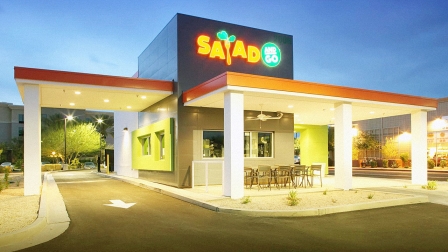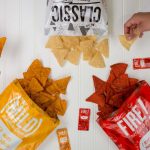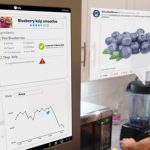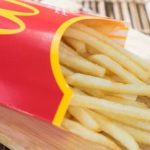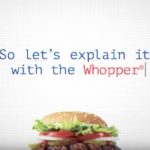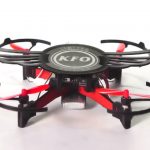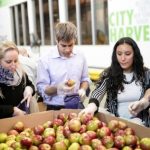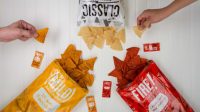Can A Drive-Thru Salad Bar Change Fast Food Forever?
The pioneers of the “fast-casual” restaurant world—including Shake Shack and Chipotle—still lack one staple ingredient of the classic fast-food dining experience: A drive-thru window. Enter Salad and Go, a restaurant chain based in Arizona that is selling healthy meals for less than $6 from a traditional drive-thru window.
“We kept saying over and over again, why can’t I just get something great tasting and good for you with the same convenience, speed, and price of traditional drive-thru fast food?” says Roushan Christofellis, who founded the chain in 2013. So, the former elementary school teacher created one. Here, she discusses the inspiration behind her idea and how the Salad and Go concept is evolving.
What inspired you to create Salad and Go?
Our story started about five years ago. I was just about to turn 30. My husband’s a few years older than me. We both started having our parents deal with some health issues, specifically heart disease, which is really hard, obviously, when you are watching your parents go through [everything from] heart attacks to bypass surgery. It was kind of this unique point where we were seeing our parents as young in our eyes, and we were old enough to know that that’s going to be us very soon. And so that unique perspective made it really clear to us that your health is something not to be taken for granted.
We thought that as long as you went to the gym and you [stayed at a] good healthy weight, that meant you were healthy, and what we realized was we were not putting the right food into our bodies and we were really taking our health for granted. So, we started taking a close look at the food we were eating and we did our own research, and we watched movies like Food Matters and Fork Over Knife. And the message became very clear that food is medicine and you are what you eat, and there are these nutrient-rich foods and these healthy fats that we’re really missing from our diets.
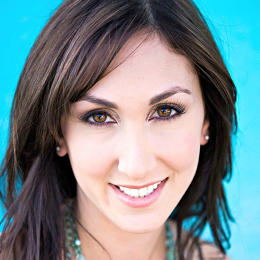
How did you decide to change your diet?
We started first at the grocery store, like, okay, grocery shop, cook from home, control what we’re eating. But it honestly didn’t last long, and I’m sure a lot of people experience this. You’re working full-time, and if you do want to get to the gym or do something after work and have meetings run late, by the time we even got home to start cooking, it was 7 p.m. I’m starving. I just want to eat. The last thing I want to do now is cook.
We found ourselves to be almost jealous of those people that would swing through the drive-thru from their air-conditioned car and be done in five minutes. It was frustrating. You either had to succumb to eating traditional drive-thru fast food if you wanted to enjoy the speed and convenience and affordability, or you were able to eat good food. We almost felt like consumers were being forced to choose between their health, and convenience and affordability.
So you and your husband decided to start your own restaurant. What was the process behind that?
We decided we were going to do something about this, and we did our research, and we quickly found that there’s a reason high-quality, fresh ingredients are definitely more expensive. To be a true alternative to drive-thru fast food, we needed to make these expensive ingredients and be able to offer the same price point as drive-thru fast food. We’re not going to be able to charge $12 for a salad and expect that someone is going to trade up from their $5, $6 combo meal for a $12 salad.
So, we said, if we’re going to create change, we’re going to need a true alternative, and that means match their speed, price, convenience, but offer that great-tasting, good food. So that’s where we really had to reengineer that business model to make up for the high food costs.
When Burger King and McDonald’s come out with salads, they still have the same amount of sugar as a soda. So how are you making this price point work?
We have that micro footprint. It’s a 656-square-foot building. We’re small. And what that does is it lowers our startup cost, our building cost, our equipment cost. It’s cheaper to operate it, and what happens is this unique space transfers over and allows us to be faster. It makes a very streamlined operation. And then, of course we have this monoproduct. We specialize in salads. We’re not trying to be everything to everyone. By specializing in something, it means that we can not only be really great at it, but we’re also buying fewer ingredients, and we’re buying a lot of those ingredients. Since we’re able to purchase thousands of pounds of romaine a day, for example, we’ve been able to partner with farmers and cut out the middleman. It makes the whole situation a lot less complicated.
[We also have] a distribution center where we’re able to now have one delivery location for all these farmers, for all our produce, so we can buy these large amounts and get fresh products every day. And then we can consolidate that labor to help reduce the risk of food safety, and create this system. Our distribution center is located within 45 minutes of all of our six locations. The restaurant industry standard is to have food costs at 28%. Well, ours are 36%. So, you have to get that 8% somewhere. That’s why our labor is a little bit less. The operating cost is where the biggest change comes from. Most restaurants are going to have close to 20% for expenses. Ours are 14%, and that’s why we’re able to put more into our food.
You said that what makes it easier is that it’s a monoproduct, but the name of the parent company is “And Go Concepts.” Do you have other Blank And Go concepts in mind?
We started & Go Concepts with the idea that we didn’t want to limit ourselves. We believe in Salad and Go staying as that monoproduct and really focusing on that. And I think that’s always an option. If we can prove this model, which we have, there could be some room for growth. So, we’ll have to see.
And do you have a timeline for when you’d like to cross state lines?
We do. We’re hoping in the next 18 to 24 months. We say, we’re going to create change in America. We’ll start with Gilbert, [Arizona].
This concept was borne in the suburbs, but it could revolutionize poor neighborhoods. Have you thought about that at all? What are your general thoughts on the way food is distributed and accessed in the U.S.?
What’s really cool is we proved that this is not a middle class concept. This is not an upper middle class concept. And that is what drives us every day. That is our mission. We’ll have people say, ‘I would pay $14 for your salad,” and we say, “Well, if you’re willing to spend $14 for a salad then clearly you’re doing something right.” You value your food and you can afford it, and you have that luxury. But what’s really great is we have people that come to us and say, ‘I have swapped you out from my normal drive-thru stomping ground.’ And that’s what’s so cool: Our salads and our price are the same as a traditional drive-thru salad.
They’re 48 oz. in size, so they’re much larger than what you would get anywhere else. And we were recently able to up our organic offering. Now all of our kale, spinach, mixed greens, cucumbers, and apples are organic. So, now you’re getting a salad with a bunch of freshly chopped organic ingredients and house-made dressings for $5.74. So it’s making it virtually where there’s no excuse now. That’s what we’re trying to do is make it where there’s no excuse. There’s options now. I think that’s pretty huge, that we were able to dismiss people saying, ‘Oh, I can’t eat healthy because it’s too expensive or it’s not convenient.’
What advice do you have for people who feel like they’re getting to the end of that time in their lives where they can make a pivot like you did?
My advice would be to make sure you’re going into it for the right reasons, and to believe that what you’re doing is going to create that change that you’re looking for. Because it’s full of sacrifice, it’s full of hard work. I mean, you’re all in. And it doesn’t necessarily get easier, it just gets different. I was teaching and I loved what I was doing. I think that’s also why we’ve been successful. I have to be doing something I believe in, whether that was teaching or now doing something like this, where I really feel like I’m creating change in consumers’ lives, that’s what drives it every day, and makes me want to keep going.
Fast Company , Read Full Story
(44)

